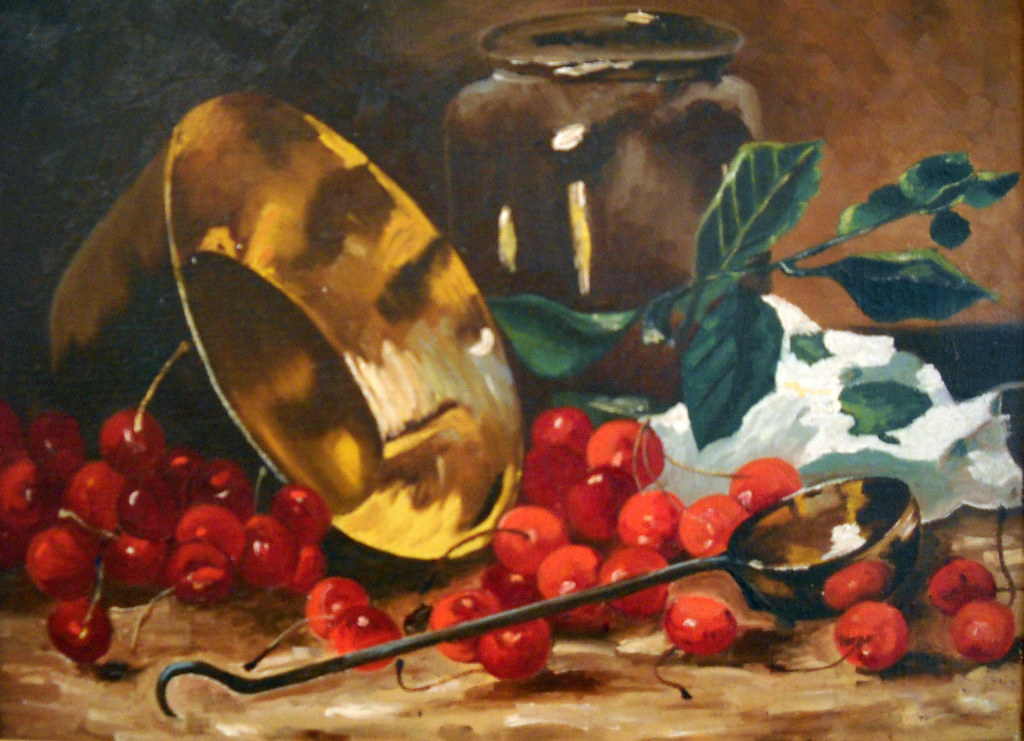Jam is certainly an alchemy between sugar and fruits or vegetables, but not only ......
What could be more comforting than a generous slice of toast, garnished with jam, the queen of spreads is so easy to make that it would be a shame not to start, Beautiful fruits, fresh, canned, frozen, a little u of sweet spices, and voila! Whether you like simple recipes, or more daring flavors. In your basins, ready, fire, cook!
Some definition
JAM
Since the Middle Ages, jams have been prepared according to one of the simplest principles: so much for so much. It is therefore a question of candying, in small broth, a weight of fruit and its equivalent of sugar. For the jam, we keep the pieces of fruit. We have just found that it is quite possible to make some variations to update these recipes by sweetening less, or even by gelling using agar agar. The term jam responds, in commerce, to a simple regulation: the preparation must contain a minimum of 35% fruit, or 65% sugar. For the extra jam, there are 45% fruit.
MARMALADE
Marmalades are slightly thicker than jams, so the skin of the fruit is preserved. We proceed in this way for citrus preparations, or small berries that are difficult to peel.
JELLY
The jelly is clear, firm. Its translucent and shiny color is obtained by the mixture of its fruit and sugar. It is particularly suitable for filling cakes, accompanying it with cheeses and topping pies. The pectin naturally present in certain fruits gives it its gelatinous hold. Agar agar or even apple seeds accentuate this texture very clearly.
CURD
Originally from the British Isles, curd is a spread made from egg, butter, sugar and lemon. By slightly modifying the original recipe, you can flavor va curds with red berries, other citrus fruits, exotic fruits. This preparation will however keep for a shorter time.
SPREAD
The spread is usually made from hazelnuts, cocoa, milk and oil. The roasted walnuts are crushed and finely mixed. They naturally turn into a slightly oily and creamy paste.
CONFIT and CHUTNEY
A salty variant of the traditional jam, the confit or chutney is a sweet and sour preparation, slightly sweet and sour, made from fruits and vegetables marinated in vinegar. They accompany with refinement verrines, cheeses, raw vegetables and salted sandwiches. They bring a chic log to the simplest starters. Also think about confits for delicious appetizing bites.
The fruit
To make a good jam, it is important to have fruit of excellent quality. My motto has always been <we only do good with excellent! > Spoiled fruit or fruit at the end of maturity should be avoided at all costs. It is necessary to have very ripe fruit for taste and not too ripe fruit: it is these that will provide the most pectin.
Certain fruits such as blackberries, blueberries and red fruits in general are very resistant to freezing. It also allows the harvest to be staggered to have enough to work with.
Sugar
I have always preferred to use the most neutral sugar possible. I find that cane sugar has a particular taste which does not respect the purity of the taste of the fruits.
Regarding this famous dilemma between two beet sugar sugars, I would like to clarify a few things: cane sugar and naturally brown, while beet sugar is naturally white. It is not a chemical process that takes away its color. It is therefore a misconception to think that white sugar is more natural than brown sugar.
This is the same sugar (sucrose) that is stored in the root of sugar cane or beet.
The caloric value of brown sugar is slightly lower than that of white sugar, but its sweetening power also which, reduced to the portions consumed, does not make a big difference.
You can also in some cases replace sugar with honey, it is delicious with certain fruits such as apples or pears, for example!
The amount of sugar to use obviously varies depending on the fruit and what you want to do. The rule of thumb for jellies is 50% fruit and 50% sugar. Regarding the jam, a very sweet fig or plum will be satisfied with 450 to 500gr / kg but for the majority of fruits, the appropriate dose will be 700gr / kg.
For a professional jam maker, the total amount of sugar after cooking required by law must be at least 55%. Its unit of measurement is the “Brix”. If this is not the case, we will not be able to call the preparation jam and it will be necessary to sterilize.
For the housewife who wants to consume less sugar, nothing prevents her from making a preparation with 300 or 400gr of sugar per kg and then sterilizing.
The lemon
It is for me a basic ingredient. It has an essential role in the success of a jam.
It serves to balance acidity, it acts as a disinfectant and provides a large amount of pectin.
It must be organic. Freezing improves its qualities by bursting the cells. Simply immerse it in water to defrost it quickly, cut it in half and put it in the cauldron at the start of cooking, then wring it out and discard it at the end of cooking. It will thus have released all its pectin.
Lemon juice will balance the sweetness and the acidity. We can say in general that for a kg of fruit, it is necessary:
- 2 tablespoons of lemon juice for rather acidic fruits (grapes, peaches, apricots)
- 4 tbsp of lemon juice for less acidic fruits (cherries, strawberries, pears)
Always taste during cooking because it is obviously easier to add than to remove ...
The little extras
These are the ingredients that are usually added at the end of cooking, among which I will mention:
Vanilla, dried fruits (walnuts, almonds, hazelnuts, dried apricots, prunes, raisins, ...), salt (always a small pinch), peppers (black, Timuth, Sechouan, pink berries ...) spices (cinnamon, cardamom, bergamot, cloves, turmeric, ginger…), herbs (mint, rosemary, thyme, anise, saffron, elderflower…) alcohols and liqueurs can also contain a multitude of flavors.
This list is of course not exhaustive, you just have to dare!
Confection
The making of a jam will always vary from person to person: you can give a kilo of apricots and a recipe to 50 different jam makers, none of the jams will be the same as another on arrival. This is where the knack comes in, the little trick that makes all the difference. You don't write a feel, a color, a shine or the size of a bubble in a recipe, or even the power of fire or the thickness of the cauldron.
Regarding the latter, it goes without saying that copper should always be preferred. Its strengths are multiple. It is an excellent conductor of heat which will allow even cooking. It is also of great importance in the consistency of the jam because the copper has the ability to fix the pectin of the fruits. The proof is that when the cauldron is empty, the jam that sticks to the walls is incredibly hard.
In general, a jam should be made as quickly as possible. There are however a few variations depending on the raw material used.
The red fruits are satisfied with 20 to 30 minutes of cooking, while the zucchini or the melon for example, must bathe a few hours in the sugar so that the latter penetrates to the heart. The faster the jam cooks, the more fruit will retain their color and aroma.
Skimming should always be done at the end of cooking, just before potting. The scum contains a lot of pectin which the jam will "swallow" little by little during cooking and help gel.
I usually say that a jam is made in the last five minutes. This is where the appearance will change, it will take on a brilliant color, the bubbles will become smaller: the jam takes!
To find out whether to stop cooking, I take a ramekin or a small plate that I put in the freezer to cool and pour a teaspoon of my preparation into it. Two or three minutes are enough to have the final result.
Potting
Throughout this operation the fire must remain lit so that the jam does not cool. A jam funnel is an indispensable tool.
I am not at all adept at turning the jar because I find that it soils the lids and is frankly not necessary when using new capsules. It is a custom arose among housewives who used for several years in a row pots used to put either a tomato paste or the jam of the previous year ... obviously, the tightness of the lid being strongly compromised , in this case it is preferable to turn the pot upside down to ensure the vacuum. In our case we will always use new capsules.
Gelling agents
Texture is first and foremost a matter of taste and most jams only need fruit and sugar, or even a little lemon.
However, it takes a very important part in the success of a recipe. It is not only a product that will make it possible to obtain it, but a multitude of small things:
Work in copper, mix a small part of the Cauldron in order to obtain more consistency, respect the cooking times, and of course take into account the very essence of the fruits because some gel naturally thanks to the pectin they contain .
I am not a big fan of added pectins, pure or already incorporated in so-called "special jam" sugars. I much prefer to use agar-agar.
Fruits rich in pectin: apples, quinces, lemons and oranges, blackcurrant, apricot ...
Fruits low in pectin: strawberry, cherry, tomato, pear, peach ...
Agar-agar is a tasteless seaweed powder, quite natural, well known to Asians, which has a strong gelling power, but beware: the latter varies enormously with the acidity of the fruit. So be careful also when adding lemon. The more acidic the preparation, the less active the agar-agar will be.

